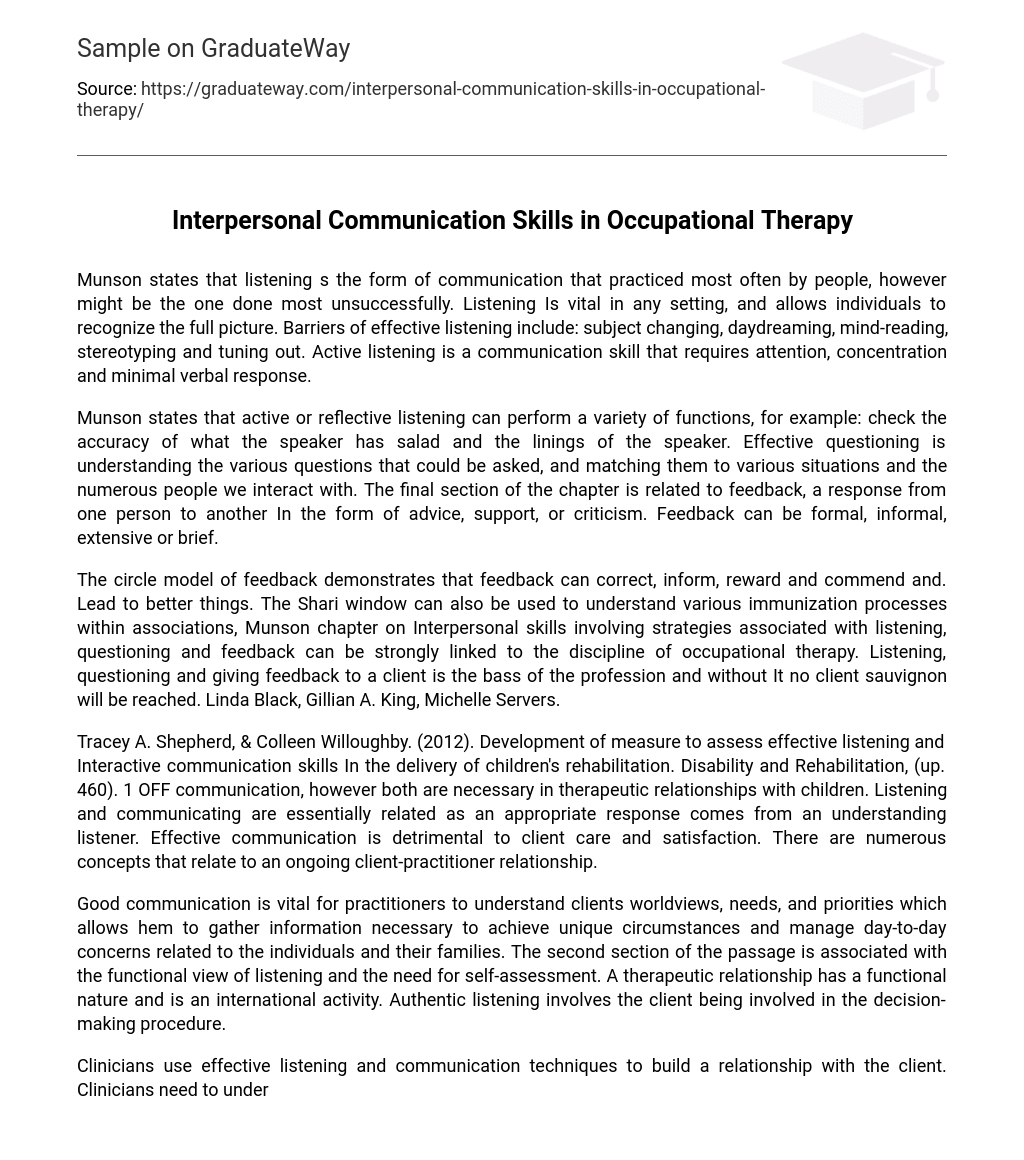Munson states that listening s the form of communication that practiced most often by people, however might be the one done most unsuccessfully. Listening Is vital in any setting, and allows individuals to recognize the full picture. Barriers of effective listening include: subject changing, daydreaming, mind-reading, stereotyping and tuning out. Active listening is a communication skill that requires attention, concentration and minimal verbal response.
Munson states that active or reflective listening can perform a variety of functions, for example: check the accuracy of what the speaker has salad and the linings of the speaker. Effective questioning is understanding the various questions that could be asked, and matching them to various situations and the numerous people we interact with. The final section of the chapter is related to feedback, a response from one person to another In the form of advice, support, or criticism. Feedback can be formal, informal, extensive or brief.
The circle model of feedback demonstrates that feedback can correct, inform, reward and commend and. Lead to better things. The Shari window can also be used to understand various immunization processes within associations, Munson chapter on Interpersonal skills involving strategies associated with listening, questioning and feedback can be strongly linked to the discipline of occupational therapy. Listening, questioning and giving feedback to a client is the bass of the profession and without It no client sauvignon will be reached. Linda Black, Gillian A. King, Michelle Servers.
Tracey A. Shepherd, & Colleen Willoughby. (2012). Development of measure to assess effective listening and Interactive communication skills In the delivery of children’s rehabilitation. Disability and Rehabilitation, (up. 460). 1 OFF communication, however both are necessary in therapeutic relationships with children. Listening and communicating are essentially related as an appropriate response comes from an understanding listener. Effective communication is detrimental to client care and satisfaction. There are numerous concepts that relate to an ongoing client-practitioner relationship.
Good communication is vital for practitioners to understand clients worldviews, needs, and priorities which allows hem to gather information necessary to achieve unique circumstances and manage day-to-day concerns related to the individuals and their families. The second section of the passage is associated with the functional view of listening and the need for self-assessment. A therapeutic relationship has a functional nature and is an international activity. Authentic listening involves the client being involved in the decision-making procedure.
Clinicians use effective listening and communication techniques to build a relationship with the client. Clinicians need to understand client concerns, situations and priorities to enable momentum towards intervention strategies. Listening and communication skills are essential to pediatric rehabilitation services, without them it is difficult for a clinician to achieve insight into a clients life. The final fragment of the passage identifies that feedback is critical throughout the therapeutic field, however a challenge to maintain in clinical practices.
The passage is directly related to all therapeutic fields, that including occupational hereby. The authors state that effective communication is detrimental to client satisfaction, which in occupational therapy is essential. In the discipline of occupational therapy it is important to build a trusting relationship with the client, this relies heavily on the listening and communication skills of the practitioner. Gina Castle Bell, Elizabeth M. Mine’, Melissa C. Robinson & Harry Wager Jar. (2014). The Relative Effectiveness of Active Listening in Initial Interaction. International Journal of Listening, (up. 4-17). The passage states that ranges of occupational and therapeutic disciplines consider active listening to be an essential communication skill. The article also states that clients that receive active listening responses had a greater sense of feeling understood then a client who received unpretentious advice. Further into the passage the authors Justify that partakers were more satisfied with holding a conversation that involved active listening responses and advice. Practitioners from various disciplines associate active listening as the base of initial interactions.
Active listening incorporates three elements: expressing interest, refraining from Judgmental feedback, and asking relevant questions. Active listeners communicate with empathy and build a trusting relationship with the participant. The second section of the passage relates initial interactions with participants to listening processes. First impressions determine potential future interactions. Effective listeners commonly construct more satisfying impressions than ineffective listeners. The most effective method of listening is active listening.
The final section f the article implies that active listening creates positive outcomes more often than not. Effective listening processes also include: feeling positive affect, relationship rewarding interactions. Majority of the passage is describing the importance of active listening skills. Numerous tactics are used in active listening to maximize the satisfaction of the participant. Most of the information isn’t directly related to the discipline of occupational therapy, however all strategies could be applied throughout client interaction to strengthen client care and satisfaction.





